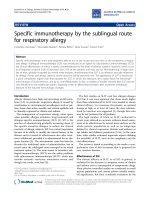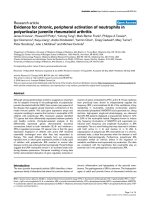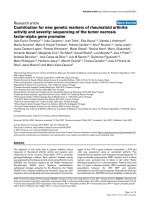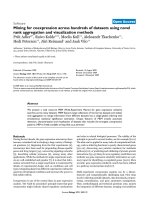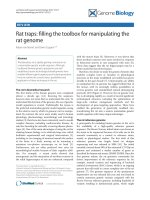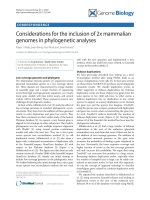Báo cáo y học: "Curricula for teaching the content of clinical practice guidelines to family medicine and internal medicine residents in the US: a survey study" ppt
Bạn đang xem bản rút gọn của tài liệu. Xem và tải ngay bản đầy đủ của tài liệu tại đây (259.03 KB, 8 trang )
BioMed Central
Page 1 of 8
(page number not for citation purposes)
Implementation Science
Open Access
Research article
Curricula for teaching the content of clinical practice guidelines to
family medicine and internal medicine residents in the US: a survey
study
Elie A Akl*
1,2
, Reem Mustafa
1
, Mark C Wilson
3
, Andrew Symons
2
,
Amir Moheet
4,5
, Thomas Rosenthal
2
, Gordon H Guyatt
6,7
and
Holger J Schünemann
7
Address:
1
Department of Medicine, State University of New York at Buffalo, NY, USA,
2
Department of Family Medicine, State University of New
York at Buffalo, NY, USA,
3
Department of Internal medicine, University of Iowa, IA, USA,
4
Department of Medicine, Rochester General Hospital,
Rochester, NY, USA,
5
Department of Medicine, University of Rochester, NY, USA,
6
Department of Medicine, McMaster University, Hamilton, ON,
Canada and
7
Department of Clinical Epidemiology & Biostatistics, CLARITY Research Group, McMaster University, Hamilton, ON, Canada
Email: Elie A Akl* - ; Reem Mustafa - ; Mark C Wilson - ;
Andrew Symons - ; Amir Moheet - ; Thomas Rosenthal - ;
Gordon H Guyatt - ; Holger J Schünemann -
* Corresponding author
Abstract
Background: Teaching the content of clinical practice guidelines (CPGs) is important to both
clinical care and graduate medical education. The objective of this study was to determine the
characteristics of curricula for teaching the content of CPGs in family medicine and internal
medicine residency programs in the United States.
Methods: We surveyed the directors of family medicine and internal medicine residency programs
in the United States. The questionnaire included questions about the characteristics of the teaching
of CPGs: goals and objectives, educational activities, evaluation, aspects of CPGs that the program
teaches, the methods of making texts of CPGs available to residents, and the major barriers to
teaching CPGs.
Results: Of 434 programs responding (out of 839, 52%), 14% percent reported having written
goals and objectives related to teaching CPGs. The most frequently taught aspect was the content
of specific CPGs (76%). The top two educational strategies used were didactic sessions (76%) and
journal clubs (64%). Auditing for adherence by residents was the primary evaluation strategy (44%),
although 36% of program directors conducted no evaluation. Programs made texts of CPGs
available to residents most commonly in the form of paper copies (54%) while the most important
barrier was time constraints on faculty (56%).
Conclusion: Residency programs teach different aspects of CPGs to varying degrees, and the
majority uses educational strategies not supported by research evidence.
Published: 21 September 2009
Implementation Science 2009, 4:59 doi:10.1186/1748-5908-4-59
Received: 3 July 2008
Accepted: 21 September 2009
This article is available from: />© 2009 Akl et al; licensee BioMed Central Ltd.
This is an Open Access article distributed under the terms of the Creative Commons Attribution License ( />),
which permits unrestricted use, distribution, and reproduction in any medium, provided the original work is properly cited.
Implementation Science 2009, 4:59 />Page 2 of 8
(page number not for citation purposes)
Background
The implementation of clinical practice guidelines
(CPGs) has been shown to positively impact clinical care.
For example, the implementation of community-acquired
pneumonia guidelines has decreased mortality [1] and
improved cost effectiveness of care [2] without adverse
patient consequences [3]. Diabetes care employing evi-
dence-based guidelines [4] reduced diabetic nephropathy,
retinopathy, and autonomic neuropathy. Improved sur-
vival in women with node-negative breast cancer has been
associated with compliance with guidelines for systemic
adjuvant treatment [5]. Use of guidelines for the manage-
ment of presumed uncomplicated urinary tract infection
in women has decreased laboratory utilization and overall
costs while maintaining or improving the quality of care
[6].
On the post graduate medical education level, teaching
the content of CPGs can help in achieving three of the six
general competencies defined by the Accreditation Coun-
cil for Graduate Medical Education (ACGME) in the
United States (US) [7]: patient care, medical knowledge,
and practice-based learning and improvement [8]. It is
also assumed that such teaching will help trainees to
adhere to CPGs when they become independent practi-
tioners.
In spite of their clinical and educational values, the imple-
mentation of CPGs remains suboptimal among family
medicine and internal medicine trainees in the US for a
number of clinical areas such as: management of hyper-
tension [9]; management of hypercholesterolemia [10];
diagnosis and management of uncomplicated urinary
tract infection [11]; screening and management of chronic
kidney disease and its associated co-morbidities [12]; and
screening for familial colorectal cancer [13].
One of the potential explanations for the suboptimal
implementation of CPGs is suboptimal teaching of CPGs
in residency programs. The main objective of this study
was to determine the characteristics of curricula for teach-
ing the content of CPGs in family medicine and internal
medicine residency programs in the US. We also wanted
to explore the hypothesis that a lower percentage of inter-
national medical graduates would be associated with bet-
ter characteristics of teaching CPGs. It was not our
objective to study either informal teaching (i.e., outside
the curriculum, e.g., bedside teaching) or teaching of
guidelines' development or guidelines' integration in
medical decision making.
Methods
Study design
We conducted a national survey of directors of family
medicine and internal medicine residency programs in
the US. We identified the program directors and obtained
their contact information using the American Medical
Association Graduate Medical Education Directory [14].
The University at Buffalo Institutional Review Board
approved the study.
Survey questionnaire
To develop the questionnaire, we reviewed the medical lit-
erature including the ACGME definition of a curriculum
[15] and the Cochrane Effective Practice and Organisation
of Care (EPOC) review group typology of implementation
interventions [16]. We also conducted discussions with
five internal medicine chief residents and two program
directors attending the American College of Physicians
(ACP) and the Association of Program Directors in Inter-
nal Medicine (APDIM) 2005 annual meetings. Two cur-
rent and one previous program director reviewed iterative
versions of the questionnaire and provided feedback.
The survey questionnaire included questions about the
characteristics of the teaching of CPGs: goals and objec-
tives, educational activities, evaluation, aspects of CPGs
that the program teaches, the methods of making texts of
CPGs available to residents, and the major barriers to
teaching CPGs. The questionnaire included additional
questions about the characteristics of the program director
(gender, years as program director) and the characteristics
of the residency program (geographical region, affiliation,
number of residents, and percentage of international
medical graduates) (Additional File 1).
Data collection
We mailed program directors the initial invitation to par-
ticipate in the survey in April 2007. We used the following
survey methods demonstrated to maximize response rate
[17,18]: university sponsorship, personalized cover letter,
colored ink, stamped return envelope, first class mailing,
follow-up mail, including a questionnaire in the follow-
up mail, non-monetary incentive, and a questionnaire
that is interesting, short, user friendly, with factual ques-
tions, and with more relevant questions first. The non-
monetary incentive consisted of a Microsoft PowerPoint
version of an educational game designed to teach CPGs
and using rules similar to those of the TV show Jeopardy
®
[19]. We sent a follow-up mail and a follow-up fax respec-
tively five and nine weeks after the initial invitation.
Statistical analysis
We conducted the descriptive analyses for the two special-
ties (family medicine and internal medicine) separately
and combined. We conducted regression analyses in order
to identify factors that are associated with the characteris-
tics of the teaching of CPGs. We used logistic models with
each of the options for the characteristics of the teaching
of CPGs as a dependent variable, and the specialty, the
Implementation Science 2009, 4:59 />Page 3 of 8
(page number not for citation purposes)
program director characteristics, and the residency pro-
gram characteristics as the independent variables (refer-
ence categories for the categorical variables were
respectively: internal medicine specialty, male gender,
Northeast geographical region, community based pro-
grams, and <25% international medical graduates). We
report only statistically significant associations with odds
ratio (OR) <0.8 or OR <1.25. We used Microsoft Office
Access for data entry and management and SPSS, version
13.0 (SPSS, Inc., Chicago, Illinois), for all analyses.
Results
The survey overall response rate was 52% (434 out of 839;
52% and 51% of family medicine and of internal medi-
cine program directors responding, respectively). Table 1
lists the characteristics of the training programs combined
and separately for the two specialties.
Table 2 presents the answers of responding program direc-
tors relating to questions about teaching of CPGs com-
bined and separately for the two specialties.
Table 1: The characteristics of responding program directors and of their residency programs; a national survey, 2007
Combined Family Medicine Internal Medicine
N = 434 N = 239 N = 195
Gender of program director, n (%)
Female 98 (23) 48 (20) 50 (26)
Years as director, mean (SD) 7.3 (5.4) 6.9 (5.1) 7.7 (5.6)
Geographical region, n (%)
Northeast 129 (30) 47 (20) 82 (42)
South 112 (26) 69 (29) 43 (22)
Midwest 119 (27) 79 (33) 40 (21)
West 68 (16) 40 (17) 28 (14)
Affiliation, n (%)
Community based 294 (68) 182 (76) 112 (57)
University based 113 (26) 41 (17) 72 (37)
Military based 15 (3) 8 (3) 7 (4)
Other 6 (1) 4 (2) 2 (1)
Number of residents per program, mean (SD) 36.5 (28.5) 22.0 (8.1) 53.8 (34.0)
International graduates, n (%)
<25% 174 (40) 108 (43) 66 (34)
25 to 50% 85 (20) 53 (22) 32 (16)
51 to 75% 76 (18) 43 (18) 33 (17)
>75% 94 (22) 31 (13) 63 (32)
Implementation Science 2009, 4:59 />Page 4 of 8
(page number not for citation purposes)
Table 2: Answers to questions relating to teaching of the content of clinical practice guidelines; a national survey, 2007
Combined Family Medicine Internal Medicine
N = 434 N = 239 N = 195
Goals and objectives
Yes 61 (14) 32 (13) 29 (15)
Aspects of CPGs taught
Identifying and locating CPGs 310 (71) 191 (80) 119 (61)
Critical appraisal of CPGs 222 (51) 130 (54) 92 (47)
Content of specific CPGs 329 (76) 185 (77) 144 (74)
Dealing with conflicting CPGs 127 (29) 82 (34) 45 (23)
None 37 (9) 12 (5) 25 (13)
Other 20 (4.6) 15 (6.2) 5 (2.6)
Educational activities to teach CPGs
Making texts of CPGs available 229 (53) 126 (53) 103 (53)
Didactic sessions 331 (76) 196 (82) 135 (69)
Interactive sessions 154 (36) 83 (35) 71 (36)
Journal club 276 (64) 157 (67) 119 (61)
Audit and feedback to residents * 163 (38) 99 (41) 64 (33)
Self-audit by residents 90 (21) 50 (21) 40 (21)
Educational games 75 (17) 41 (17) 34 (17)
None 23 (5) 5 (2) 18 (9)
Other 25(5.8) 15 (6.3) 10 (5.1)
Evaluation of the teaching of CPGs
Objective assessment of knowledge 151 (35) 79 (33) 72 (37)
Assessment of attitude 45 (10) 23 (10) 22 (11)
Auditing of resident adherence * 190 (44) 123 (51) 67 (34)
Assessment of satisfaction 40 (9) 23 (10) 17 (9)
None 157 (36) 78 (33) 79 (41)
Other 17 (3.9) 9 (3.7) 8 (4.1)
Implementation Science 2009, 4:59 />Page 5 of 8
(page number not for citation purposes)
Written goals and objectives
Fourteen percent of responding program directors
reported having written goals and objectives for teaching
CPGs.
Aspects of CPGs
The most frequently taught aspect of CPGs was the con-
tent of specific CPGs (76%). Nine percent of program
directors reported teaching no aspect of CPGs. Teaching
how to identify and locate CPGs and teaching critical
appraisal of CPGs were associated with family medicine
specialty (OR = 2.70; 95% Confidence Interval (CI) 1.52
to 4.80) and OR = 1.81; 95% CI 1.10 to 3.07 respectively).
Teaching the content of specific CPGs was inversely asso-
ciated with 51 to 75% of residents being international
medical graduates (OR = 0.44; 95% CI 0.22 to 0.88).
Teaching how to deal with conflicting CPGs was associ-
ated with female gender of the program director (OR =
2.00; 95% CI 1.17 to 3.38), and inversely associated with
26 to 50% of residents being international medical grad-
uates (OR = 0.45; 95% CI 0.23 to 0.89).
Educational activities
The top educational activity was didactic sessions (76%).
Five percent of program directors reported using no edu-
cational activity.
Didactic sessions were associated with family medicine
specialty (OR = 2.27; 95% CI 1.24 to 4.15). Journal clubs
was inversely associated with 51 to 75% of residents being
international medical graduates (OR = 2.05; 95% CI 1.07
to 3.92). Audit and feedback was inversely associated with
26 to 50% of residents being international medical grad-
uates (OR = 0.49; 95% CI 0.27 to 0.49). Interactive ses-
sions were associated with 26 to 50% of residents being
international medical graduates (OR = 1.78; 95% CI 1.02
to 3.08).
Evaluation
The most frequently reported evaluation strategy was
auditing of residents' adherence (44%). Thirty six percent
of program directors reported conducting no evaluation.
CPGs texts made available through
The website of the program 142 (33) 79 (33) 63 (32)
Servers of affiliated hospital(s) 181 (42) 102 (43) 79 (41)
email distribution 76 (18) 44 (18) 32 (16)
Personal digital assistant (PDA) 107 (25) 85 (36) 22 (11)
Paper copies 236 (54) 136 (57) 100 (51)
None 20 (5) 7 (3) 13 (7)
Other 47 (10.8) 25 (10.46) 22 (11.3)
Barriers
Limited access to CPGs 31 (7) 13 (5) 18 (9)
Insufficient interest among residents 72 (17) 35 (15) 37 (19)
Insufficient interest among faculty 96 (22) 41 (17) 55 (28)
Time constraints on residents 214 (49) 118 (49) 96 (49)
Time constraints on faculty 245 (56) 140 (59) 105 (54)
None 94 (22) 53 (22) 41 (21)
35 (8.0) 22 (9.2) 13 (6.7)
*Audit can be used as an evaluation strategy but also as an educational strategy if coupled with by feedback or conducted by the residents
themselves.
CPGs = Clinical Practice Guidelines
Table 2: Answers to questions relating to teaching of the content of clinical practice guidelines; a national survey, 2007 (Continued)
Implementation Science 2009, 4:59 />Page 6 of 8
(page number not for citation purposes)
Auditing adherence to CPGs was associated with family
medicine specialty (OR = 1.72; 95% CI 1.01 to 2.94) and
inversely associated with 26 to 50% of residents being
international medical graduates (OR = 0.45; 95% CI 0.26
to 0.80). Conducting objective assessment of knowledge
was inversely associated with family medicine specialty
(OR = 0.52; 95% CI 0.30 to 0.90).
Making texts of CGPs available
Paper copies were the most frequent format programs
used to make texts of CPGs available to residents (54%).
Five percent of the program directors reported using no
specific strategy to make texts of CPGs available to the res-
idents. Making texts of CPGs available through PDAs was
associated with family medicine specialty (OR = 3.92;
1.94 to 7.93).
Barriers
The top reported barrier was the time constraints on fac-
ulty (56%). Twenty two percent of responding program
directors reported no barriers. Considering time con-
straints on faculty as a barrier was associated with 26 to
50% of residents being international medical graduates
(OR = 2.05; 95% CI 1.15 to 3.66).
Discussion
We conducted a survey of family medicine and internal
medicine residency programs to determine how family
medicine and internal medicine residency programs in
the US teach the content of CPGs to their residents. Four-
teen percent of program directors reported having written
goals and objectives related to CPGs. The most frequently
taught aspect of CPGs was the content of specific CPGs
(76%). Educational activities were predominantly didac-
tic in nature (76%). Auditing for adherence by residents
was the primary evaluation strategy (44%), while 36% of
program directors reported conducting no evaluation.
Programs made texts of CPGs available to residents most
frequently in the form of paper copies (54%), while the
most important barrier was time constraints on faculty
(56%).
This study has two main strengths. First, the survey ques-
tionnaire was rigorously designed, pretested, and is based
on the EPOC review group typology of implementation
strategies and ACGME definition of curriculum. Second,
and to our knowledge, this is the first survey attempting to
describe the teaching of the content of CPGs in both fam-
ily medicine and internal medicine residency programs.
The main limitation of this study is the potential for selec-
tion bias with a response rate of 52%. This response rate,
however, is consistent with the mean response rate of
54% to surveys of physicians published in medical jour-
nals [18]. On the other hand, surveys of pediatricians were
found to be very consistent in showing only small
amounts of response bias regardless of the response rate
[20]. If selection bias existed, it is likely that teaching of
the content of CPGs in the programs of responding direc-
tors would be of higher quality than in those of non-
responding directors. This implies that our results could
reflect an optimistic characterization of teaching of the
content of CPGs in general, emphasizing the need for
improvement. Another important limitation is that the
study did not address important aspects of training in
CPGs such as bedside teaching (i.e., in concert with the
care of individual patients) and integrating guidelines in
medical decision making. These are however more chal-
lenging research questions that would require different
study designs and different target populations to address
them. In addition, the questionnaire was not detailed
enough to capture details of the educational strategies
(e.g., type of auditing); however, this was intended to keep
the questionnaire relatively short and increase response
rate.
If teaching of the content of CPGs is considered an impor-
tant part of the curriculum, programs will need to develop
relevant goals and objectives. Goals and objectives offer a
general focus, clarify expectations for learning and attain-
ment, and relate them to residents' clinical and didactic
activities [21]. Goals and objectives are also important for
any evaluation process because outcomes are results pro-
viding evidence that goals and objectives have been
accomplished [21]. We believe that such goals and objec-
tives should cover basic skills, such as searching for and
critically appraising CPGs, and more advanced skills, such
as integrating CPGs in medical decision making, particu-
larly those decisions that are sensitive to patients' values
and preferences and for which guideline implementation
is not equivalent to 100% adherence.
It is encouraging that the majority of programs teach the
content of specific guidelines. The challenge remains
however with the teaching strategy. The effectiveness of
the top two strategies used by the majority of programs
(i.e., didactic sessions and journal clubs) is not supported
by research evidence. A systematic review assessing the
effectiveness of didactic sessions concluded that they are
unlikely to change professional practice [22]. A review of
the literature about the use of journal clubs identified no
studies assessing their impact on adherence to CPGs [23].
On the other hand, the effectiveness of two teaching strat-
egies used by a minority of programs (i.e., interactive ses-
sions and audit and feedback) is supported by high
quality research evidence. A systematic review assessing
the effectiveness of interactive workshops concluded that
they can result in moderately large changes [22]. Another
systematic review found that audit and feedback can be
Implementation Science 2009, 4:59 />Page 7 of 8
(page number not for citation purposes)
effective in improving professional practice [24]. The
effects are small to moderate, but likely to be greater when
baseline adherence to recommended practice is low and
when feedback is delivered more intensively [24]. Further-
more, the improved compliance may be generalizable to
recommended practices not directly targeted for audit[25]
The time constraints on faculty being the most reported
barrier to teaching of the content of CPGs, potential solu-
tions include integrated approaches to evidence-based
practice and teaching [26], resident-led small-group
teaching [27], online tutorials [28], and educational
games [29]. The effectiveness of some of these strategies
remains to be proven. While the limited availability of
CPGs was found in the past to be a barrier to the use of
CPGs [30], the findings of this survey shows an improve-
ment in guidelines accessibility in both paper or elec-
tronic forms, as also suggested by a recent survey of family
medicine residency directors [31].
A number of reported characteristics of the teaching of
CPGs were better for family medicine than for internal
medicine residency programs (e.g., identifying and locat-
ing CPGs) and vice versa (e.g., conducting objective
assessment of knowledge). However, the overall results
are similar for the two specialties. The challenges are thus
not unique to one of the two disciplines highlighting the
need for collaborative efforts. We had hypothesized that a
lower percentage of international medical graduates
would be associated with better characteristics of teaching
CPGs; although some of the associations were statistically
significant, they were not consistent enough to support
our hypothesis.
Conclusion
The findings of this study have important implications for
graduate medical education. Taking into account compet-
ing demands and requirements, program directors need to
consider the value of teaching of the content of CPGs on
the clinical care and educational levels (evidence-based
medicine user model [32]). The teaching of the content of
CPGs can benefit from adherence to the ACGME guide-
lines for curricular design. A particular attention should
be given to the educational strategies used given their var-
ying effectiveness.
The findings have also important implications for
research. Time constraints on faculty being the major bar-
riers, research should evaluate the effectiveness of innova-
tive strategies that may consume less faculty time, such as
online tutorials [28], case-based on-line learning [33],
and educational games [29]. An additional challenge is to
identify ways to facilitate incorporation of CPGs into deci-
sion making rather than simple conformance [8]. Future
research should also investigate in other educational set-
ting, the interesting association between the female gen-
der and the higher number of years as program director
with positive curricular characteristics. However, the
major question to explore remains whether teaching of
the content of CPGs in residency influences future practice
behavior of physicians, particularly integrating CPGs in
decision making in a manner that is consistent with the
individual patient values and preferences.
Competing interests
The authors declare that they have no competing interests.
Authors' contributions
Authors contributions: conception and design: EAA, RM,
MCW, AM, and HJS; acquisition of data: EAA, RM, AS,
MCW, AM, and TR; analysis and interpretation of data:
EAA, GHG, and HJS; drafting of manuscript: EAA; critical
revision of the manuscript for important intellectual con-
tent: EAA, RM, AS, MCW, AM, TR, GHG, and HJS; obtain-
ing of funding: EAA, RM, and HJS.
Additional material
Acknowledgements
We thank Ann Grifasi, Ethel Sharp, Denise McGuigan, and Karen Devlin for
their administrative assistance. We also thank all directors of family medi-
cine residency and internal medicine programs who contributed to this
study. Research for Health in Erie County, Inc., the Graduate Medical Edu-
cation of the University at Buffalo, and the Society of General Internal Med-
icine (through a Founders Award to EAA) funded this study. HJS is funded
by a European Commission: The human factor, mobility and Marie Curie
Actions. Scientist Reintegration Grant (IGR 42192). The sponsors had no
role in study design; in the collection, analysis, and interpretation of data; in
the writing of the manuscript; and in the decision to submit the manuscript
for publication. All authors read and approved the final manuscript.
References
1. Dean NC, Silver MP, Bateman KA, James B, Hadlock CJ, Hale D:
Decreased mortality after implementation of a treatment
guideline for community-acquired pneumonia. The American
Journal of Medicine 2001, 110:451-457.
2. Nathwani D, Rubinstein E, Barlow G, Davey P: Do Guidelines for
Community Acquired Pneumonia Improve the Cost Effec-
tiveness of Hospital Care? Clinical infectious diseases 2001,
32:728-741.
3. Marrie TJ, Lau CY, Wheeler SL, Wong CJ, Vandervoort MK, Feagan
BG, for the CSI: A Controlled Trial of a Critical Pathway for
Treatment of Community-Acquired Pneumonia. JAMA 2000,
283:749-755.
4. Gaede P, Vedel P, Larsen N, Jensen GV, Parving HH, Pedersen O,
Gaede P, Vedel P, Larsen N, Jensen GVH, et al.: Multifactorial
intervention and cardiovascular disease in patients with type
Additional file 1
Survey questionnaire. Reproduces the questionnaire sent to the study par-
ticipants.
Click here for file
[ />5908-4-59-S1.DOC]
Publish with BioMed Central and every
scientist can read your work free of charge
"BioMed Central will be the most significant development for
disseminating the results of biomedical research in our lifetime."
Sir Paul Nurse, Cancer Research UK
Your research papers will be:
available free of charge to the entire biomedical community
peer reviewed and published immediately upon acceptance
cited in PubMed and archived on PubMed Central
yours — you keep the copyright
Submit your manuscript here:
/>BioMedcentral
Implementation Science 2009, 4:59 />Page 8 of 8
(page number not for citation purposes)
2 diabetes[see comment]. New England Journal of Medicine 2003,
348:383-393.
5. Hebert-Croteau N, Brisson J, Latreille J, Rivard M, Abdelaziz N, Mar-
tin G, Hebert-Croteau N, Brisson J, Latreille J, Rivard M, et al.: Com-
pliance with consensus recommendations for systemic
therapy is associated with improved survival of women with
node-negative breast cancer[see comment]. Journal of Clinical
Oncology 2004, 22:3685-3693.
6. Saint S, Scholes D, Fihn SD, Farrell RG, Stamm WE, Saint S, Scholes
D, Fihn SD, Farrell RG, Stamm WE: The effectiveness of a clinical
practice guideline for the management of presumed uncom-
plicated urinary tract infection in women. American Journal of
Medicine 1999, 106:636-641.
7. Accreditation Council for Graduate Medical Education
(ACGME) Outcomes Project [ />]
8. Staton L, Kraemer S, Patel S, Talente G, Estrada C: Peer chart
audits: A tool to meet Accreditation Council on Graduate
Medical Education (ACGME) competency in practice-based
learning and improvement. Implementation Science 2007, 2:24.
9. Jami P, Smith P, Moningi S, Moningi V, Martin SA, Rosencrance G,
Reyes BJ: Compliance with Joint National Committee 7 guide-
lines in hypertension management in a teaching institu-
tion.(Clinical report). American Journal of Medical Quality 2007,
22:251(258):.
10. Goebel LJ, Bailony F, Khattak AJ, Gress TW, Goebel LJ, Bailony F,
Khattak AJ, Gress TW: Physician and patient barriers to adher-
ence with cholesterol guidelines. West Virginia Medical Journal
2006, 102:23-26.
11. Grover ML, Bracamonte JD, Kanodia AK, Bryan MJ, Donahue SP,
Warner AM, Edwards FD, Weaver AL, Grover ML, Bracamonte JD,
et al.: Assessing adherence to evidence-based guidelines for
the diagnosis and management of uncomplicated urinary
tract infection. Mayo Clinic Proceedings 2007, 82:181-185.
12. Lenz O, Fornoni A: Chronic kidney disease care delivered by
US family medicine and internal medicine trainees: results
from an online survey. BMC Medicine 2006, 4:30.
13. Barrison AF, Smith C, Oviedo J, Heeren T, Schroy PC 3rd, Barrison
AF, Smith C, Oviedo J, Heeren T, Schroy PC 3rd: Colorectal can-
cer screening and familial risk: a survey of internal medicine
residents' knowledge and practice patterns. American Journal of
Gastroenterology 2003, 98:1410-1416.
14. Graduate Medical Education Directory [https://cata-
log.amassn.org/Catalog/product/product_detail.jsp?produc
tId=prod1160010]
15. Glossary [ />]
16. Cochrane Effective Practice and Organisation of Care
Review Group: Data Collection Checklist [http://
www.epoc.cochrane.org/Files/Website/Reviewer%20Resources/
Data%20Collection%20Checklist%20-%20EPOC%20-%202007-Feb-
27.doc]
17. Edwards P, Roberts I, Clarke M, DiGuiseppi C, Pratap S, Wentz R,
Kwan I, Cooper R, Edwards P, Roberts I, et al.: Methods to increase
response rates to postal questionnaires[see comment].
Cochrane Database of Systematic Reviews 2007:MR000008.
18. Asch DA, Jedrziewski MK, Christakis NA: Response Rates to Mail
Surveys Published in Medical Journals. Journal of Clinical Epide-
miology 1997, 50:1129-1136.
19. Akl EA, Mustafa R, Slomka T, Alawneh A, Vedavalli A, Schunemann HJ,
Akl EA, Mustafa R, Slomka T, Alawneh A, et al.: An educational
game for teaching clinical practice guidelines to Internal
Medicine residents: development, feasibility and acceptabil-
ity. BMC Medical Education 2008, 8:50.
20. Cull WL, O'Connor KG, Sharp S, Tang SF, Cull WL, O'Connor KG,
Sharp S, Tang S-fS: Response rates and response bias for 50 sur-
veys of pediatricians. Health Services Research 2005, 40:213-226.
21. Robertson WW: The Goals and Objectives Made Easier.
ACGME Bulletin 2007:2.
22. Forsetlund L, Bjørndal A, Rashidian A, Jamtvedt G, O'Brien MA, Wolf
F, Davis DA, Odgaard-Jensen J, Oxman AD: Continuing education
meetings and workshops: effects on professional practice
and health care outcomes. Cochrane Database of Systematic
Reviews 2009, 4:CD003030.
23. Lee AG, Boldt HC, Golnik KC, Arnold AC, Oetting TA, Beaver HA,
Olson RJ, Carter K: Using the Journal Club to Teach and Assess
Competence in Practice-based Learning and Improvement:
A Literature Review and Recommendation for Implementa-
tion. Survey of Ophthalmology 2005, 50:542-548.
24. Jamtvedt G, Young JM, Kristoffersen DT, O'Brien MA, Oxman AD:
Audit and feedback: effects on professional practice and
health care outcomes. Cochrane Database of Systematic Reviews
2006:CD000259.
25. Holmboe E, Scranton R, Sumption K, Hawkins R, Holmboe E, Scran-
ton R, Sumption K, Hawkins R: Effect of medical record audit
and feedback on residents' compliance with preventive
health care guidelines. Academic Medicine 1998, 73:901-903.
26. Akl EA, Izuchukwu IS, El-Dika S, Fritsche L, Kunz R, Schunemann HJ:
Integrating an evidence-based medicine rotation into an
internal medicine residency program. Academic Medicine 2004,
79:897-904.
27. Garfield D, Atre-Vaidya N, Sierles F:
Teaching the APA Practice
Guidelines to Psychiatry Residents: A Novel Strategy. Aca-
demic Psychiatry 2002, 26:70-75.
28. Bell DS, Fonarow GC, Hays RD, Mangione CM: Self-Study from
Web-Based and Printed Guideline Materials: A Randomized,
Controlled Trial among Resident Physicians. Ann Intern Med
2000, 132:938-946.
29. Akl EA, Schünemann HJ: Guide-O-Game: an educational game
to improve Internal Medicine residents' knowledge and
adherence to clinical practice guidelines. In Evidence Based Clin-
ical Practice newsletter McMaster University; 2008:12.
30. Bachman KH, Mazur DJ: Using practice guidelines to teach res-
idents. Acad Med 1998, 73:118-119.
31. Nowalk MP, Zimmerman RK, Middleton DB, Sherwood RA, Ko FS,
Kimmel SR, Troy JA, Nowalk MP, Zimmerman RK, Middleton DB, et
al.: An evaluation of immunization education resources by
family medicine residency directors. Family Medicine 2007,
39:715-719.
32. Akl EA, Maroun N, Neagoe G, Guyatt GG, Schünemann HJ: EBM
user and practitioner models for graduate medical educa-
tion: what do residents prefer? Medical Teacher 2006,
28:192-194.
33. Stewart M, Marshall JN, Ostbye T, Feightner JW, Brown JB, Harris S,
Galajda J, Stewart M, Marshall JN, Ostbye T, et al.: Effectiveness of
case-based on-line learning of evidence-based practice
guidelines. Family Medicine 2005, 37:131-138.
